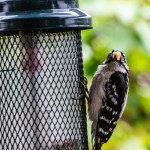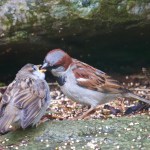Birding: Local bird life in the real world
Published 2:25 pm Thursday, July 10, 2025




It has been a few weeks since I began to see fledglings, especially waterfowl babies out and about on the ponds or munching on grasses and plants at the water’s edge. Horned grebe fledglings are riding on their mother’s back while the other parent brings them and their mother their meals, and American coots are feeding their fledglings.
Red-wing blackbird babies are hiding in the bulrushes with their wings flapping fast and furiously and their beaks are wide open hoping to encourage their mother to hurry up with breakfast. All the wing flapping made it possible to see a few of the babies and their mom in action. She came in for the feed with a beak filled with insects, then stuck her beak into the gaping mouth of her young and shoved the protein in. She was off in a flash to find more protein for another of her babies.
One of them was so well hidden in the reeds that its momma and I were unable to see it. It must have known that it was missing out on breakfast! To remedy the situation, it came flying out from under the bulrushes and plopped down right out in the open where all could see, including its mother. It worked! It received the next beakful of insects.
Trending
One poor red-wing mother was the victim of fake news! She had one baby, but it wasn’t a red-wing baby. It was much more demanding and bigger than a red-wing fledgling and it didn’t stay in the marsh for its meals. It had managed to fly onto a tree branch. Can you guess who this baby was? This species is parasitic on other species by laying their eggs in the nests of other birds, usually those that are much smaller than themselves, such as the yellow warbler or the white-crowned sparrow. Parenting is done by the host species. The “fake baby” was a brown-headed cowbird!
Yellow-headed blackbirds are birds of the prairies, but they are often seen at the Ridgefield Wildlife Refuge. I had the good fortune to see a few yellow-headed blackbird fledglings a few weeks ago. Unlike the red-wing fledglings that hid in the vegetation, yellow-headed young were sitting out in the open on a bulrush stalk. Mouths were open and a lot of squawking was going on! Several parents were busy with their youngsters the day I happened by the marsh.
One pair of Canada geese parents I have been seeing are down to three youngsters from seven. They are beginning to look like teenagers. I wonder whether they are as difficult as some human teenagers? I came across another set of Canada goose parents that were busy looking after their family of eight. And some of the mallards are already busy with a second family, or so it appears. Is it a second nesting or a first? It seems a bit late for being a first, but one never knows!
Three species that love to dine on suet, especially the insect and mealworm laden suet that we have been putting out, are feeding it to their young. The black-capped chickadee, red-breasted nuthatch and downy woodpecker parents spend most of their day at the suet feeder or on the nutty delight feeder that contains balls of suet among the tasty peanuts, walnuts and pecans. Once the parent’s beak is full, it flies off to feed its young.
The nuthatch is now bringing one of its babies close to the feeder. It is a lot less work when the baby is close at hand. One day, the chickadee parents stashed their two fledglings in a flowering tree within sight of the feeder. They spent an hour or so flying back and forth with mouthfuls of suet laced with mealworms and insects. The suet is homemade by friends who own and operate a wild bird store! Mmm, good! It is the best according to the birds.
Life in the real world is not so bad when you are fed on demand and protected from danger, but I wonder whether the young yearn for the nest after they have left home? Perhaps achieving adult independence in the real world is better than life in the nest, even with its ever present dangers. Happy birding!
Trending













